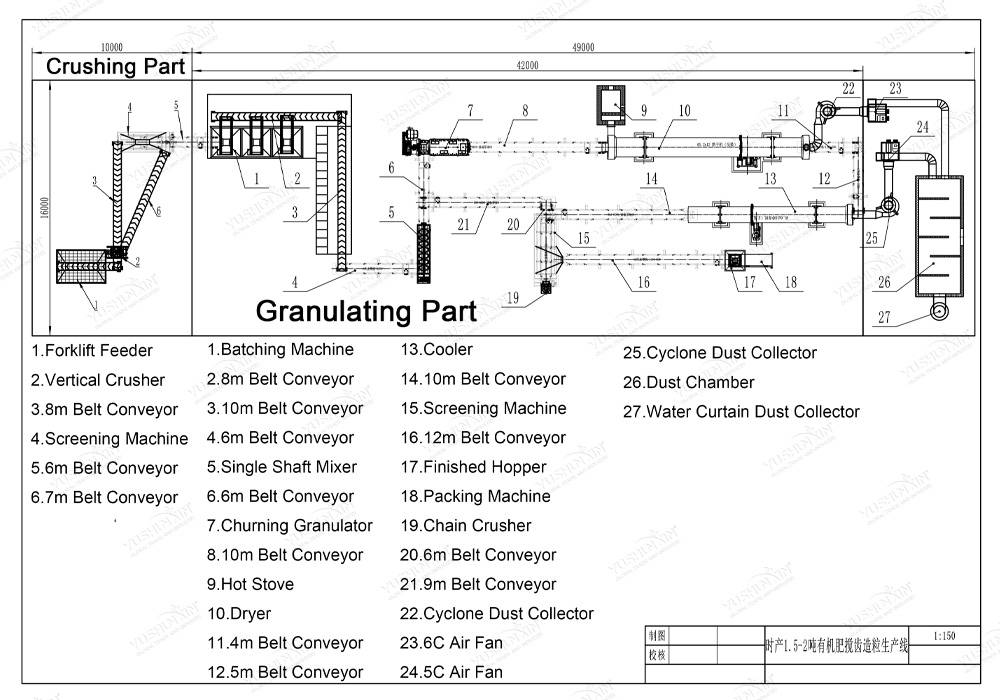







To convert phosphate rock into a usable fertilizer form, acid is required to “acidulate” the rock, which releases soluble phosphorus compounds. Common acids used include:
To create NPK mēslošanas līdzekļi, other sources of nitrogen and potassium can be mixed with the phosphate material. Some examples include:
Katras ražošanas līnijas izmaksas mainās atkarībā no ražošanas jaudas, automatizācijas pakāpe, un īpašas vajadzības. Aizpildiet zemāk esošo veidlapu, un mēs jums sniegsim precīzu citātu!
Ja jūs interesē mūsu mēslojuma izgatavošanas aprīkojums, Lūdzu, iesniedziet savas prasības un kontaktus, un tad mēs ar jums sazināsimies divās dienās. Mēs apsolām, ka visa jūsu informācija nevienam netiks noplūdusi.
- Uzņēmums tika dibināts 2005 un ir koncentrējies uz bioloģiskā mēslojuma aprīkojuma izpēti un attīstību un ražošanu 20 gadi. Tas ir izveidojis 40 000 m liela mēroga organiskā mēslojuma aprīkojuma ražošanas bāzi, Izmantojot uzlabotu granulāciju, Žāvēšanas un skrīninga tehnoloģijas, lai uzlabotu ražošanas efektivitāti un produktu kvalitāti.
- Pašpietiekams importa un eksporta uzņēmums ar vairāk nekā 80 Profesionāli inženieri visā pasaulē, Kalpo vairāk nekā 100 valstis un reģioni visā pasaulē, 5,000+ Klientu apkalpošanas gadījumi, 10 apstrādes centri, 3 lāzera griešanas mašīnas, un vairāk nekā 60 Dažādu veidu aprīkojums.
- Ilgtermiņa un plašas sadarbības uzturēšana ar daudziem zinātniskiem pētniecības institūtiem un universitātēm, with a professional R&D team, Tas var nepārtraukti optimizēt aprīkojuma veiktspēju atbilstoši tirgus pieprasījumam.
- Augstas izturības izturīgi materiāli, Oglekļa tērauda Q235/sakausējums tiek izvēlēts, lai nodrošinātu, ka aprīkojums ir izturīgs, un samazināt uzturēšanas izmaksas.
- Inteliģentu vadības sistēmu pieņemšana, lai uzlabotu ražošanas automatizācijas līmeni un samazinātu manuālo atkarību.
- Iso, Cekuls, SGS starptautiskā sertifikācija
- Ar liela mēroga ražošanas jaudu, tas var atbilst dažādas ražošanas jaudas prasības (mazs, Vidējas un lielas ražošanas līnijas).
- Pilns aprīkojuma modeļu klāsts, Piemērots dažāda veida mēslošanas līdzekļu, piemēram, organiskā mēslojuma, ražošanai, salikts mēslojums, bioloģiskais mēslojums, ūdenī šķīstošs mēslojums, šķidrs mēslojums, utt..
- Personalizētu dizainu var nodrošināt atbilstoši klientu vajadzībām, ieskaitot ražošanas jaudu, vietas izkārtojums, Vides aizsardzības standarti, utt..
- Nodrošiniet pilnu ražošanas līnijas risinājumu komplektu, ieskaitot aprīkojuma izvēli, uzstādīšana un nodošana ekspluatācijā, tehniskā apmācība, utt..

- Tiešā rūpnīcas piegāde, Samazināt starpnieku saiti, Un cena ir konkurētspējīgāka.
- Iekārtai ir augsta energoefektivitāte, samazina enerģijas patēriņu, un palīdz klientiem samazināt ilgtermiņa darbības izmaksas.
- Tiešā rūpnīcas piegāde, Samazināt starpnieku saiti, Un cena ir konkurētspējīgāka.
- Iekārtai ir augsta energoefektivitāte, samazina enerģijas patēriņu, un palīdz klientiem samazināt ilgtermiņa darbības izmaksas.
Mēslošanas līdzekļu pulēšanas mašīnas piegāde vadošajam mēslošanas līdzekļu ražotājam Nīderlandē
Veiksmīga 1T/H dubulto rullīšu granulatoru piegāde klientiem Turcijā un Apvienotajā Karalistē
Efektīvs komposta virpošanas risinājums, kas piegādāts klientam Filipīnās
Veiksmīga disku granulatora piegāde Čīles klientam mēslošanas līdzekļu ražošanai
Granulēšanas efektivitātes paaugstināšana GoodEarth grupai, Dienvidāfrika